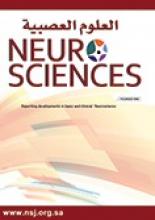Abstract
OBJECTIVE: To determine the protective effects of vitamin E against the damage inflicted by reactive oxygen species during toluene induced brain injury in rats using histopathological, biochemical, and behavioral parameters.
METHODS: Twenty-eight Wistar albino male rats were studied at Hacettepe University Faculty of Medicine Laboratories and Gazi University Faculty of Medicine Metabolism Laboratory in 2006. The rats were divided into 4 groups as follows: control group, toluene only treated group, both toluene and vitamin E treated group, and vitamin E only treated group. Histopathological changes were observed by hematoxylin and eosin staining and the TUNEL method. Serum lipid peroxide levels were measured by the thiobutyric acid method, and the open field test was used for behavioral testing.
RESULTS: Our results show that edema between cells in the neuropil, particularly beneath the pia mater, and around congested blood vessels was observed in all groups with different severity. However the pyknotic neurons, in addition to infiltrative cells, were observed in the toluene group to be decreased by the administration of vitamin E, which can be confirmed by the euchromatic nucleated neurons in the cortex of both the toluene and vitamin E treated groups. The levels of malondialdehyde in each group also confirmed these histopathological findings. Significant differences were also found in the open field test between the groups.
CONCLUSION: The differences between the toluene and vitamin E groups in biochemical, histologic, and behavioral examinations, supports the antioxidant protective role of vitamin E against the harmful effect of toluene on the brain.
- Copyright: © Neurosciences
Neurosciences is an Open Access journal and articles published are distributed under the terms of the Creative Commons Attribution-NonCommercial License (CC BY-NC). Readers may copy, distribute, and display the work for non-commercial purposes with the proper citation of the original work.






